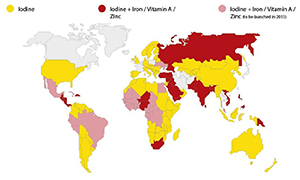Nutrition landscaping for effective fortification
- Like
- Digg
- Del
- Tumblr
- VKontakte
- Buffer
- Love This
- Odnoklassniki
- Meneame
- Blogger
- Amazon
- Yahoo Mail
- Gmail
- AOL
- Newsvine
- HackerNews
- Evernote
- MySpace
- Mail.ru
- Viadeo
- Line
- Comments
- Yummly
- SMS
- Viber
- Telegram
- Subscribe
- Skype
- Facebook Messenger
- Kakao
- LiveJournal
- Yammer
- Edgar
- Fintel
- Mix
- Instapaper
- Copy Link
Posted: 16 October 2013 | Nestlé | No comments yet
Nestlé is helping address micronutrient deficiencies in the developing world by mapping nutritional gaps…


Nestlé is helping address micronutrient deficiencies in the developing world by mapping nutritional gaps.
Nestlé collects and analyses publicly available information from local governments and international health authorities about specific dietary gaps in the developing world.
The process, called nutritional landscaping, reveals where there is a need for micronutrients including iodine, iron, zinc and vitamin A.
Health impact
Products fortified with these vitamins and minerals can then be developed to help meet consumers’ needs.
A lack of such micronutrients in the diet can have a devastating and long-lasting impact on human health.
A deficiency in iron in infancy and early childhood, for example, can have a lifelong impact on mental development and cognitive functioning. Other effects of iron deficiency include fatigue, weakness and an increased risk of infectious diseases.
Nutritional gaps
The UN estimates that two billion people around the world suffer from micronutrient deficiencies. It calls this “hidden hunger”.
Nestlé uses information to identify dietary needs both geographically and within a specific population group. Often, it is young children and women of child-bearing age who could most benefit from fortified foods.
Already, Nestlé has collated data from Peru, Venezuela, Brazil, the Philippines, Indonesia, Malaysia and Vietnam. It is also looking at Oman, Saudi Arabia, the United Arab Emirates Jordan, Lebanon, Nigeria, Ghana and Pakistan.


MAGGI MAP: Showing the reach of fortified Maggi products in 2012.
Long history
Nestlé has a long history of fortification, beginning with an iron-enriched version of the very first Nestlé product – Farine Lactée – and continuing for more than 145 years.
Hundreds of products – from stock cubes, to soup mixes, from breakfast cereals to biscuits – are now enriched with key nutrients to improve the diets of consumers.
Fortified milk
The mapping process enables Nestlé to enrich existing products with specific micronutrients, to change the way it communicates about these products or to create entirely new ones.
In Venezuela, for example, 30% of women and children are low in iron. Bouillon was identified as a good carrier for iron and five new fortified products have been introduced.
In Brazil, where there is a high prevalence of deficiencies in vitamin A, iron and iodine, as well as a low intake of calcium and magnesium, fortified products have been adapted to fulfill these requirements.
In the Philippines, where more than a third of pre-school age children have anaemia, Nestlé has introduced an iron-fortified milk.
Sharing value
Micronutrient fortification works. A recent independent study published on the effects of micronutrient fortified milk and cereal foods for infants and children concluded that they can be an effective option for reducing anaemia in children up to three years of age in developing countries.
In 2012, Nestlé sold over 150 billion servings of fortified products. The goal is to reach 200 billion fortified servings worldwide by 2016.
Nestlé believes that it can create value for its shareholders by doing business in ways that specifically help address global and local issues in the areas of nutrition, water and rural development.
The micronutrient fortification programme is just one example of how this is achieved.




